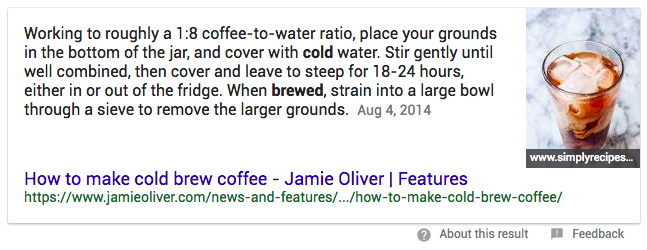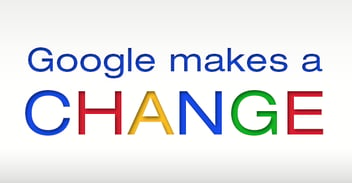
Near the end of 2017, Google made a major change to how they display snippets (AKA meta descriptions) in organic search results. According to a SISTRIX analysis, before mid-November, more than 90% of all-text snippets were only one or two rows (165 characters or less) long. By the beginning of December, over 50% displayed three rows or more (around 300 characters, on average). Google made this update to give searchers better answers to their queries.
What does this mean for the meta descriptions you write for your website pages moving forward? Should you increase the length? Do you need to go back into all of your old pages and make updates? We’ve been asking these same questions, so we looked to some of the world’s leading marketing experts for answers.
What is a meta description?
We’ll start at the very beginning—a very good place to start. A meta description is a concise and accurate summary of a web page’s content that appears on search engine results pages (SERPs) underneath the blue clickable links. It often contains some or all of the search query. My search query in this example was "how to make cold brew."

How is a "featured snippet" different?
Some people confuse snippets (meta descriptions) with featured snippets, so I want to offer some clarification before we go any further. A featured snippet is the content displayed in a box above the regular search results, also known as position #0. It’s a summary extracted from a webpage that answers the question posed in the search query. It also includes a link, page title, and URL. Featured snippet results can change over time, as Google is constantly working to provide the most useful and relevant answers for search queries.

This is all we'll cover concerning featured snippets in this article. When I use the term "snippet" from here on out, I'm referring to meta descriptions displayed in Google search results.
Now that we got the basics out of the way, we can jump into the research that will help us find answers to our questions concerning meta description optimization in 2018.
A Moz Meta Description Analysis
LENGTH
Moz looked into their tracking data from December 15 and analyzed nearly 90,000 organic search results. Here’s what they found:
- Displayed snippets were, on average, 215 characters long
- The median character length was 186.
- About one third of the descriptions were cut off (with “…” at the end).
- Of the descriptions that were truncated, the average character length was 292.
- Video snippets were shorter (and cut sooner), on average.
- 88% of video snippets were cut off at the end.
Excluding the video data, Moz found that the majority of the descriptions displayed approximately 275–350 characters. Out of this group, they found
- The mean was 309 characters.
- The median was 317 characters.
ORIGINAL vs. GOOGLE GENERATED
Looking at that same data set, they analyzed how many snippets displayed the pre-written meta description versus how many Google pulled from the webpage content instead. Out of 70k meta descriptions,
- About 36% displayed as is.
- Google used original meta descriptions plus some additional text on 15.4% (sometimes simply by adding a period to the end of sentences).
- 2% showed a truncated version of the meta description.
- Other descriptions contained information other than the original meta description.
This means Google may or may not display your custom-written meta description in a snippet. They may instead pull directly from content on your webpage—if it offers a better answer.
Adding up those percentages above (Google using part or all of your pre-written meta description), it comes to about 55%, which is still more than half. This tells us that it’s still smart to write your meta descriptions with the goal and assumption that they will be displayed in search results.
What does Google have to say?
Google Support affirms our recommendation by telling us to make sure each page on our website has a quality meta description that accurately describes the page’s content. They also state that snippet generation (what ends up being shown on SERPs) is automated, but the on-page content, the page title, and the pre-written meta description are all taken into consideration. Google’s goal is to display a snippet that is as relevant as possible to the searcher’s query, which may or may not be the one you write for your page.
“Google will sometimes use the meta description of a page in search results snippets, if we think it gives users a more accurate description than would be possible purely from the on-page content.”
Are meta descriptions a ranking factor now?
Meta descriptions still aren’t a direct Google ranking factor, but they certainly can indirectly affect your traffic by influencing click-through-rate (CTR). Putting thought into how you write descriptions is wise since it can greatly impact your website traffic. Keep in mind that Google also bolds keywords that match search queries. If a searcher sees the words they entered into Google bolded in your meta description, there’s a better chance they’ll click on your result.
How long should my meta descriptions be moving forward?
There’s no official recommended length [from Google], but many experts recommended cutting off around 300–320 characters (because the majority of snippets are clipped there). Keep in mind that sometimes meta descriptions will still be clipped around the old limit, so try to keep the most important part of your description closer to the beginning.
Moz says to write your meta descriptions to be at least 50 characters but no more than 300, typically. Yoast suggests writing your descriptions to be 160–320 characters long. We recommend increasing your new meta descriptions to 230–320 characters, on average (there will always be some exceptions), as long as you’re writing with the needs of the searcher in mind. We’re moving forward with this new character range in mind, which gives us the opportunity to more accurately describe our content for searchers so they have a better idea of what they’ll find when they click.
The optimal length, of course, will vary for different pages. Make sure what you add is truly beneficial, and never fill anything on your website with fluff. If this means it only takes you 120 characters to do the job well, then so be it.
Should I lengthen all my old meta descriptions?
For now, we’re taking Rand Fishkin’s advice of prioritizing our most important website pages—the ones that rank the highest in search results for topics we want to rank highly for on our website. We’re analyzing the pages that receive the most organic traffic already to see if and where we can extend meta descriptions to make them more useful for searchers. After that, we’ll start diving into our other content. We’re always looking for ways to improve our website, and updating our meta descriptions is a great opportunity to do so.
How to Effectively Write Your Meta Descriptions
We’ve covered how long you should make your snippets and why. Now, let’s finish up by pointing out exactly what you should think about and include when writing them.
Advertise!
Your meta description will act as ad copy for your webpage. Your goal is to draw searchers in by proving you have solutions for their problems. Write naturally and in active voice to compose a description that accurately summarizes the contents of your page. It needs to create interest, engage the reader, and compel the reader to click. You should naturally include the keywords your page is targeting. Include enough information for the reader to understand what your content is about but not too much that it completely removes the user’s need to click for more information. Use your ~300 character limit to do a good job of drawing people in.
Other Important Tips
- Be useful by providing value.
- Make each description unique.
- Don’t use quotation marks.
- Include your focus topic or keyword, but DO NOT keyword stuff.
- Write for the user.
- Use active voice and plain English.
- Offer solutions to problems.
- Include a call to action.
- Tell the truth.
- Be descriptive.
- Summarize your page’s content in a clear, concise, and accurate way.
As Google says, “High quality descriptions can be displayed in Google’s search results and can go a long way to improving the quality and quantity of your search traffic.”
If you need help with SEO, don't hesitate to reach out to us! We have offices in Des Moines, Denver, and Huron, but we work with clients all across the country. Schedule a free consulation with us so we can start helping you improve your business website to bring you more success as soon as possible.
Google and the Google logo are registered trademarks of Google Inc., used with permission.




